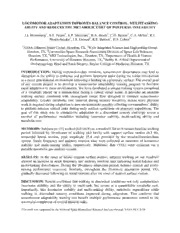
NASA Technical Reports Server (NTRS) 20110023197: Locomotor Adaptation Improves Balance Control, Multitasking Ability and Reduces the Metabolic Cost of Postural Instability PDF
Preview NASA Technical Reports Server (NTRS) 20110023197: Locomotor Adaptation Improves Balance Control, Multitasking Ability and Reduces the Metabolic Cost of Postural Instability
LOCOMOTOR ADAPTATION IMPROVES BALANCE CONTROL, MULTITASKING ABLITY AND REDUCES THE METABOLIC COST OF POSTURAL INSTABILITY J.J. Bloomberg1, B.T. Peters2, A.P. Mulavara3, R.A. Brady2, C.D. Batson4, C.A. Miller2, R.J. Ploutz-Snyder3, J.R. Guined5, R.E. Buxton5, H.S. Cohen6 1NASA-Johnson Space Center, Houston, TX, 2Wyle Integrated Science and Engineering Group, Houston, TX, 3Universities Space Research Association Division of Space Life Sciences, Houston, TX, 4MEI Technologies, Inc., Houston, TX, 5Department of Health & Human Performance, University of Houston, Houston, TX, 6Bobby R. Alford Department of Otolaryngology Head and Neck Surgery, Baylor College of Medicine, Houston, TX INTRODUCTION: During exploration-class missions, sensorimotor disturbances may lead to disruption in the ability to ambulate and perform functional tasks during the initial introduction to a novel gravitational environment following a landing on a planetary surface. The overall goal of our current project is to develop a sensorimotor adaptability training program to facilitate rapid adaptation to these environments. We have developed a unique training system comprised of a treadmill placed on a motion-base facing a virtual visual scene. It provides an unstable walking surface combined with incongruent visual flow designed to enhance sensorimotor adaptability. Greater metabolic cost incurred during balance instability means more physical work is required during adaptation to new environments possibly affecting crewmembers’ ability to perform mission critical tasks during early surface operations on planetary expeditions. The goal of this study was to characterize adaptation to a discordant sensory challenge across a number of performance modalities including locomotor stability, multi-tasking ability and metabolic cost. METHODS: Subjects (n=15) walked (4.0 km/h) on a treadmill for an 8-minute baseline walking period followed by 20-minutes of walking (4.0 km/h) with support surface motion (0.3 Hz, sinusoidal lateral motion, peak amplitude 25.4 cm) provided by the treadmill/motion-base system. Stride frequency and auditory reaction time were collected as measures of locomotor stability and multi-tasking ability, respectively. Metabolic data (VO ) were collected via a 2 portable metabolic gas analysis system. RESULTS: At the onset of lateral support surface motion, subjects walking on our treadmill showed an increase in stride frequency and auditory reaction time indicating initial balance and multi-tasking disturbances. During the 20-minute adaptation period, balance control and multi- tasking performance improved. Similarly, throughout the 20-minute adaptation period, VO 2 gradually decreased following an initial increase after the onset of support surface motion. DISCUSSION: Results confirmed that walking in discordant conditions not only compromises locomotor stability and the ability to multi-task, but comes at a quantifiable metabolic cost. Importantly, like locomotor stability and multi-tasking ability, metabolic expenditure while walking in discordant sensory conditions improved during adaptation. This confirms that sensorimotor adaptability training can benefit multiple performance parameters central to the successful completion of critical mission tasks. This work was supported by the National Space Biomedical Research Institute through NASA NCC 9-58
